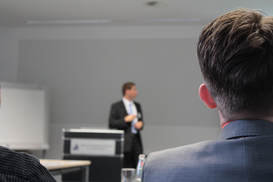
Asking people for money is a humbling experience. It is daunting and stressful knowing that the continued progress of your idea and/or the growth of your company is dependent on strangers putting their trust in you. Even though innovation, hard work and dedication all factor into a successful fundraising round, luck can’t be ignored, which is sadly out of everyone’s control. The whole process can be very emotional, especially when you are sleep deprived. But I wouldn’t give up this experience for anything, and I would encourage all to take part because there is so much to learn by it.
Here are the key lessons for someone's first fundraising pitch:
1. Before the Presentation
Preparation
Avoid Last Minute Changes
Attire
Essentials
2. During the Presentation
3. After the Presentation
After having done pitches, I feel that I am a better professional consultant and adviser for my clients. You get more and more comfortable over time.
To our readers, what were your most memorable fundraising pitch experiences? How has these experiences changed how you approach work and life?
Here are the key lessons for someone's first fundraising pitch:
1. Before the Presentation
Preparation
- If your team is not good at graphic design, consider hiring a creative design firm to help you with your presentation materials.
- Polished materials go a long way and first impressions are invaluable. Keep all materials crisp and simple.
- Rehearse, rehearse, rehearse until the “story” is second nature. Keep your descriptions simple. You are the expert with your own language. The investor needs to be able to understand you.
- Research your audience and know the key deal makers in the room.
- Save your presentation materials to several different sources, e.g. local hard drives, thumb drives, and on the cloud.
- Make sure more than one member of the team can give the pitch. You can never be too prepared - people can fall ill, emergencies occur, travel can be delayed, etc.
Avoid Last Minute Changes
- Do not make last minute changes to your presentation materials.
- Do not wait until the last minute to print your materials.
- Do not allow last minute content changes to impact your printing decisions.
- With regards to presentation materials, there will always be room for improvement and over time, many changes will be made to the content anyway.
Attire
- Pick an outfit that you feel comfortable in, and nothing too tight or too flashy.
- Wear comfortable shoes and a wardrobe that makes you feel confident.
Essentials
- Get your sleep - dark circles under the eyes are noticeable.
- Do not drink lots of coffee just ahead of the presentation; it is not worth interrupting the presentation to use the restroom.
- Do not skip meals. Eat before the presentation, but do not eat anything that will upset your stomach.
- If you are on-time to the meeting, you are late. I learned in my collegiate ROTC training that arriving early means that you have arrived on-time.
- In case your mouth goes dry, have a glass of water ready. Breath mints also are handy!
2. During the Presentation
- Investors are most interested in you – if they do not trust you or are not sold on you, they will not invest.
- Investors want to hear your story, not a recap of what appears exactly on the slides.
- Pace your speaking. Use pauses and inflections in your voice to draw in the audience.
- Do not sell to investors, engage with them. Inspire them the same way you were inspired to join this endeavor. Reach them on a personal level.
- Use storytelling and visual aids where possible – pictures, movies, prototypes, models, etc. People understand concepts in different ways and a visual aid can make an idea come to life.
- When asked questions, do not lie. If you do not know the answer to a question, acknowledge the speaker and the question, ask for clarification if necessary, and commit to follow-up later.
3. After the Presentation
- Send a personalized token of thanks to your host.
- Follow up with thank you notes right away to each of the prospective investors.
- Hand-written notes are classy!
- Ask for a follow-up meeting or discussion at the earliest convenience to sustain momentum from the meeting.
- If the prospective investors ask questions or provide feedback, be prepared to address at the next conversation.
After having done pitches, I feel that I am a better professional consultant and adviser for my clients. You get more and more comfortable over time.
To our readers, what were your most memorable fundraising pitch experiences? How has these experiences changed how you approach work and life?
Written by Jennifer Vondran

 RSS Feed
RSS Feed
